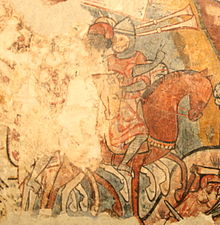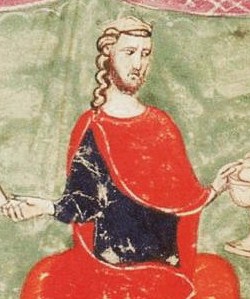
Peter III of Aragon was King of Aragon, King of Valencia, and Count of Barcelona from 1276 to his death. At the invitation of some rebels, he conquered the Kingdom of Sicily and became King of Sicily in 1282, pressing the claim of his wife, Constance II of Sicily, uniting the kingdom to the crown.

James II, called the Just, was the King of Aragon and Valencia and Count of Barcelona from 1291 to 1327. He was also the King of Sicily from 1285 to 1295 and the King of Majorca from 1291 to 1298. From 1297 he was nominally the King of Sardinia and Corsica, but he only acquired the island of Sardinia by conquest in 1324. His full title for the last three decades of his reign was "James, by the grace of God, king of Aragon, Valencia, Sardinia and Corsica, and count of Barcelona".

The Kingdom of Aragon was a medieval and early modern kingdom on the Iberian Peninsula, corresponding to the modern-day autonomous community of Aragon, in Spain. It should not be confused with the larger Crown of Aragon, which also included other territories — the Principality of Catalonia, the Kingdom of Valencia, the Kingdom of Majorca, and other possessions that are now part of France, Italy, and Greece — that were also under the rule of the King of Aragon, but were administered separately from the Kingdom of Aragon.

The Gothic Quarter is the historic centre of the old city of Barcelona. It stretches from La Rambla to Via Laietana, and from the Mediterranean seafront to the Ronda de Sant Pere. It is a part of Ciutat Vella district.

The Museu Nacional d'Art de Catalunya, abbreviated as MNAC, is a museum of Catalan visual art located in Barcelona, Catalonia, Spain. Situated on Montjuïc hill at the end of Avinguda de la Reina Maria Cristina, near Pl Espanya, the museum is especially notable for its outstanding collection of romanesque church paintings, and for Catalan art and design from the late 19th and early 20th centuries, including modernisme and noucentisme. The museum is housed in the Palau Nacional, a huge, Italian-style building dating to 1929. The Palau Nacional, which has housed the Museu d'Art de Catalunya since 1934, was declared a national museum in 1990 under the Museums Law passed by the Catalan Government. That same year, a thorough renovation process was launched to refurbish the site, based on plans drawn up by the architects Gae Aulenti and Enric Steegmann, who were later joined in the undertaking by Josep Benedito. The Oval Hall was reopened in 1992 on the occasion of the Olympic Games, and the various collections were installed and opened over the period from 1995 to 2004. The Museu Nacional d'Art de Catalunya was officially inaugurated on 16 December 2004. It is one of the largest museums in Spain.

The Museu Picasso is an art museum in Barcelona, in Catalonia, Spain. It houses an extensive collection of artworks by the twentieth-century Spanish artist Pablo Picasso, with a total of 4251 of his works. It is housed in five adjoining medieval palaces on Montcada Street in the La Ribera neighborhood in the Old City of Barcelona. It opened to the public on 9 March 1963, becoming the first museum dedicated to Picasso's work and the only one created during his lifetime. It has since been declared a museum of national interest by the Government of Catalonia.
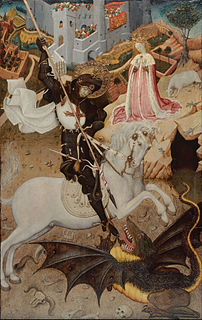
Bernat Martorell was the leading painter of Barcelona, in modern-day Spain. He is considered to be the most important artist of the International Gothic style in Catalonia. Martorell painted retable panels and manuscript illuminations, and carved sculptures and also provided designs for embroideries.
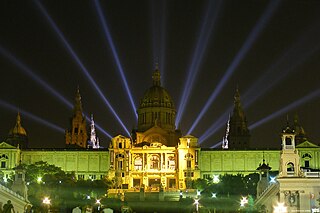
The Palau Nacional is a building on the hill of Montjuïc in Barcelona. It was the main site of the 1929 International Exhibition. It was designed by Eugenio Cendoya and Enric Catà under the supervision of Pere Domènech i Roura. Since 1934 it has been home to the National Art Museum of Catalonia.

The Llibre dels fets is the autobiographical chronicle of the reign of James I of Aragon (1213–1276). It is written in Old Catalan in the first person and is the first chronologically of the four works classified as The Four Great Catalan Chronicles, all belonging to the early medieval Crown of Aragon, and its first royal dynasty, the House of Barcelona. James I inherited as a child the titles of King of Aragon, Count of Barcelona, and Lord of Montpellier, but also became by conquest King of Majorca and King of Valencia. James emphasises in his chronicles his conquest of Majorca (1229) and of Valencia (1238).

Bernard Desclot was a Catalan chronicler whose work covering the brief reign of Peter III of Aragon (1276–85) forms one of the four Catalan Grand Chronicles through which the modern historian views thirteenth- and fourteenth century military and political matters in the Kingdom of Aragon and the Principality of Catalonia, including the "Aragonese Crusade". Desclot's Chronicle begins in the eleventh century but gains especial interest when he comes to describe events current within living memory. Bernard's literary model was Romance, and his account is spiced with dramatic monologues of the central characters and thrilling episodes, such as the escape of Peter's brother, James II of Majorca, from the fortress of Perpignan, through the castle's drains.

Jaume Huguet was a Catalan painter.
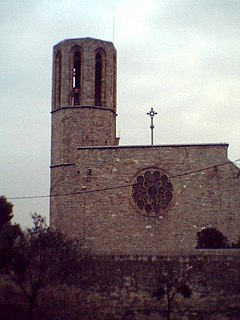
The Monastery of Pedralbes is a Gothic monastery in Barcelona, Catalonia, Spain. It is now a museum, housing permanent exhibitions on its own art and legacy as well as third-party special exhibitions from time to time. The Chapel of St. Michael was restored and re-opened in 2018.
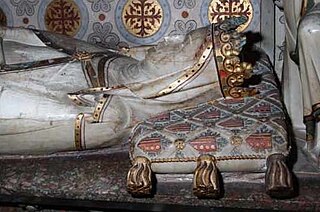
Elisenda de Montcada was queen consort of Aragon as the fourth and last spouse of James II of Aragon. She served as Regent or "Queen-Lieutenant" of Aragon during the absence of her spouse from 1324 until 1327. She was a daughter of Pere II Ramon de Montcada and Elisenda de Pinos. She and James II founded the Monastery of Pedralbes, a Franciscan convent of the Poor Clares. After James II's death in 1327, Elisenda lived adjacent to the monastery for the remaining 37 years of her life.
Catalan Gothic is an artistic style, with particular characteristics in the field of architecture. It occurred under the Crown of Aragon between the 13th and 15th centuries, which places it at the end of the European Gothic period and at the beginning of the Renaissance. The term Catalan Gothic is confined to Barcelona and its area of influence, which has its own characteristics.

The Great Day of Girona, originally El gran dia de Girona, is a large oil painting by Ramon Martí Alsina depicting an important victory of Girona's defenders over the French during the Third Siege of Girona in 1809. Completed in 1864, it is the largest easel painting in the history of Catalan art. The creation process took more than 10 years and led the artist nearly to financially ruin on several occasions. The painting became part of the collection of the Museu Nacional d'Art de Catalunya, and it is on permanent display in the Girona in an auditorium of the Catalan Government building.

The Conquest of the island of Majorca on behalf of the Christian kingdoms was carried out by King James I of Aragon between 1229 and 1231. The pact to carry out the invasion, concluded between James I and the ecclesiastical and secular leaders, was ratified in Tarragona on 28 August 1229. It was open and promised conditions of parity for all who wished to participate.
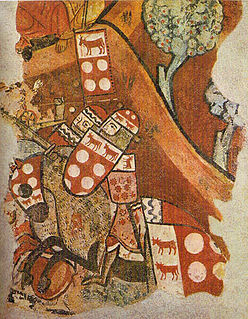
Guillem Ramon de Moncada or Guillermo II de Bearn was, from 1224 until his death in 1229, Lord of Montcada and Castellví de Rosanes and, as Guillermo II, Viscount of Bearn, of Marsan, of Gabardan and of Brulhois. He was the son of Guillem Ramon de Montcada and Guilleuma de Castellvell.

The Battle of Portopí was an open field military conflict between the Almohad troops that occupied the island of Majorca and the Christian army led by King James I the Conqueror with the aim of annexing it to the Crown of Aragon in order to expand their domain. It was carried out at various points in the current Sierra de Na Burguesa, approximately halfway between the current resort town of Santa Ponsa and the City of Majorca. It was the second major battle in the campaign for the conquest of the island of Majorca initiated by the Aragonese king.

The House of Montcada is an aristocratic and noble Spanish Catalan House with important ramifications in Sicily. Queen Elisenda of the Crown of Aragon was a member of the family.
The Four Great Catalan Chronicles were written between the late 13th century and the mid 14th century. The Chronicles narrate events of the lives of James I of Aragon, Bernat Desclot, Ramon Muntaner and Pere el Cerimoniós. The four chronicles were written with the same purpose: to justify the political actions of the rulers as well as passing their political knowledge onto their descendants. They are among the most complete historiographical sets of documents of medieval Europe, and are valued by historians for their detailed descriptions of the social and political aspects of Catalan feudal society.

